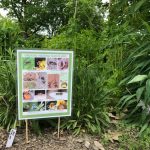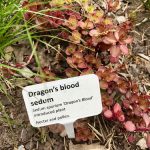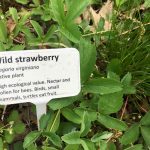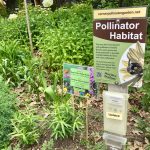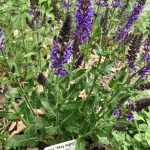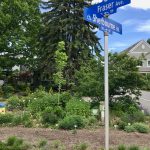By Judith van Berkom –
How often do we ask ourselves or wonder what we could do to reverse, arrest, or slow down, the effects of climate change and the extinction of bird and insect species here in the city? We feel powerless. What possible difference could one person make? But history has shown us over and over again the power of one to affect change.
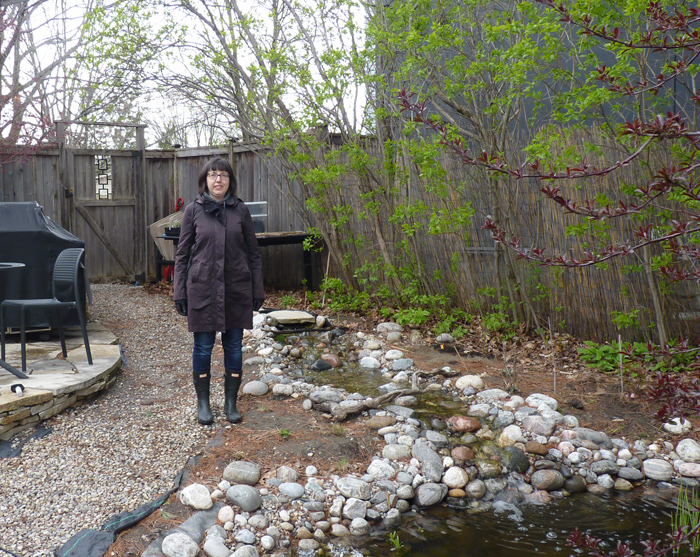
Berit Erickson has been an avid gardener for over 20 years, planting mainly for decorative purposes. Two years ago her focus changed to creating a garden that supports wildlife without using pesticides, but there was a lot more to learn.
Her inspiration came from an inner voice, which said, “there must be something I can do.” Climate change and declining insect populations were everyday news and she really wanted to do something.
“I wanted to plant the front, where it was sunny, not with grass, but with plants that would help the environment. I decided to make a pollinator garden,” she says. Bringing Nature Home by Douglas Tallamy and Gardens of the High Line by Piet Oudolf, both available from the Ottawa Public Library, inspired, guided her choices, and provided the information needed to get started.
“I was completely unfamiliar with native plants. Once I learned that I could attract bees, butterflies, and birds, using plants, I had to start all over,” Berit explains.
She calls it her Corner Pollinator Garden, and it really began when a cedar tree had to be removed as a result of ice and snow overhanging the street. This area became the site of a garden dedicated to native plants and the feeding of native bees, butterflies and birds. It’s on full view to anyone who wants to see it, at the corner of Fraser and Sherbourne Avenue.
[See what’s growing in Berit’s garden right now. Click images to enlarge.]
“I did a lot of research. I had been trying to attract hummingbirds for the last 20 years. Last year I had a couple of juveniles around the garden quite a bit. I had plants for nectar but you also need plants that attract insects. They need insects for protein – any birds really. I didn’t know hummingbirds ate insects.”
These two years have been ones of discovery. Berit says she’s not an expert, but is eager to encourage others to create their own pollinator garden with native plants and to share the knowledge she’s gained so far. On her website (cornerpollinatorgarden.net) she shares information about creating a garden using native plants to attract and sustain wildlife.
Last summer she put in a pond with a stream in her backyard. She’s been planting more shrubs and trees, providing nesting places and berries in the fall for birds to eat. She didn’t realize how much providing water would help. With the hot, dry summer last year, she had many families of birds coming for a drink.
“We had warblers – who usually eat insects in the canopy of trees – come down when they heard the sound of the water,” says Berit.
The goal of a pollinator garden is to provide a variety of native plants, trees and shrubs that cover the growing season from early spring to the end of the fall. Berit explains that the “easiest” season is the fall when asters and goldenrod are in bloom. They are good for monarch butterflies and the stems of some varieties become cavity nest sites for bees and are host plants to some kinds of butterflies and moths. “They are power plants really.”
The spring is when woodland plants flower, taking advantage of the sunlight before the trees come out. Flowering shrubs and trees are also important. The first to bloom is the pussy willow and the wild plum, which hosts hundreds of moths for bird food. Chipmunks will eat the fruit in the fall.
The summer features a variety of pollinators. Berit choses plants with hot colours – oranges, reds, adding white and yellow flowers. “I am very interested in hummingbirds and plant a lot of red flowers,” she says. “Jewel Weed, if you are able to get it, has an orange tubular flower with a lot of nectar.”
There are several plant sales in the ward where one can buy native plants but it can get expensive. Berit decided to use seeds, and explains that many native plants need to go through the winter – called stratification – and can be planted in pots outside in the snow germinating the following spring.
Berit often has passersby stopping to see her garden and ask questions. She’s put up a sign, and provides brochures with information. Sometimes there are free seeds in small packages too, so neighbours can start their own pollinator gardens.

